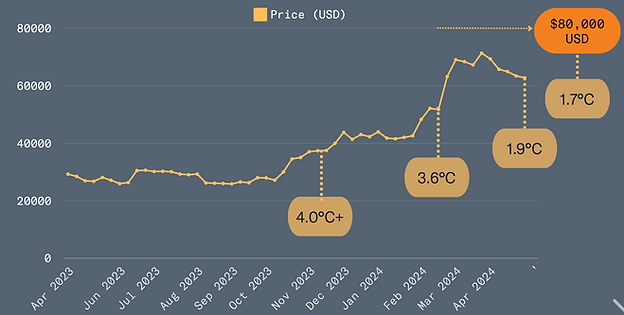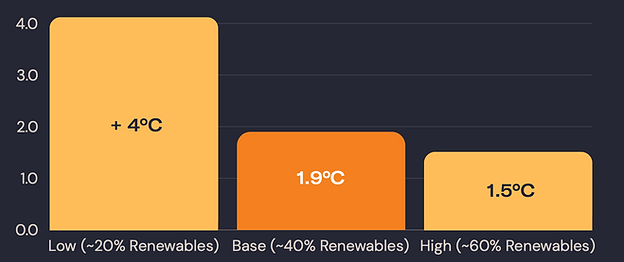
Bitcoin's price ($BTC) has been skyrocketing since the SEC permitted the launch of spot-Bitcoin ETF's in January 2024. The likes of BlackRock Inc. and Fidelity Investments have opened the floodgates for both institutional and retail investment: specifically around $53 billion of inflows in the US alone (Bloomberg). US crypto exchange-traded products make up 84% of global crypto fund assets, however, managers in Australia, Hong Kong and beyond are hurriedly trying to capitalise on the 'Crypto Summer' by getting approval of their own. These floodgates have opened just in time for the lead up to Bitcoin’s in-built ‘halving’.
As Bitcoin's price and adoption grow, so too does the network's energy consumption and, consequently, its carbon footprint. Bitcoin's current price stands at USD 63,126, a staggering 216% year-over-year increase. Alongside this price surge, the network's greenhouse gas emissions have also risen to 88.8 MTCO2e per year, marking a 45% year-over-year growth.
Our analysis shows that each Bitcoin currently contributes approximately 4.3 tonnes of CO2 equivalent per year. To put this into perspective, we need to assess how Bitcoin's carbon footprint stacks up against global carbon budgets and climate goals.
Categorising Bitcoin's Emissions
Categorising Bitcoin's emissions is not as clear-cut as it is for traditional assets. Depending on the perspective – whether you view owning bitcoin as owning part of the network or simply holding a commodity – Bitcoin's emissions could fall under Scope 1, 2, or 3. For this analysis, we focus on the ongoing energy cost of the network, not the embedded carbon in mining hardware.
Temperature Alignment Analysis
We use a value-to-carbon metric that provides insights into the temperature alignment of the Bitcoin network with global carbon budgets. Using Scope 1 budgets presents a balanced view of transition risk, as it assumes that owning bitcoin is equivalent to owning part of the network. At current prices, our analysis shows that Bitcoin is aligned with a 1.9-degree world.
However, Bitcoin's price volatility can significantly affect the temperature alignment. As the price fluctuates, so does the dollar value of Bitcoin relative to its carbon emissions. This means that the temperature alignment can range from 1.7°C to over 4°C, depending on market conditions.

Renewable Energy Mix
Another critical factor determining Bitcoin's carbon footprint is the renewable energy mix powering the network. Estimates suggest that approximately 60% of Bitcoin's energy consumption comes from fossil fuels. However, Bitcoin's carbon efficiency can improve as miners shift to renewable energy sources and energy grids become cleaner.

Graph: BTC Temperature Alignment Based on Grid Renewables %
Is this the same for all cryptocurrencies?
No. Bitcoin's reliance on a Proof-of-Work (PoW) consensus mechanism means it requires significant computational power and energy consumption to validate transactions and secure the network. In contrast, other cryptocurrencies like Ethereum and Solana have transitioned to the more energy-efficient Proof-of-Stake (PoS) consensus mechanism. PoS relies on validators staking their own tokens to secure the network, resulting in significantly lower carbon emissions compared to Bitcoin's PoW system.

Source: CCRI Crypto Sustainability Metrics
The Way Forward
As Bitcoin's growing popularity and institutional adoption raise important questions about its environmental impact, it is crucial for investors to push for greater transparency around Bitcoin's energy consumption and support initiatives to make mining more sustainable. By encouraging the use of renewable energy sources and promoting the development of more energy-efficient mining equipment, we can work towards greening Bitcoin and ensuring its long-term sustainability.
In conclusion, while Bitcoin's meteoric rise has captured the attention of investors worldwide, it is essential to consider the climate risk associated with its growth. By understanding the factors that contribute to Bitcoin's carbon footprint and advocating for more sustainable practices, we can help shape a future where cryptocurrencies and environmental responsibility go hand in hand.



